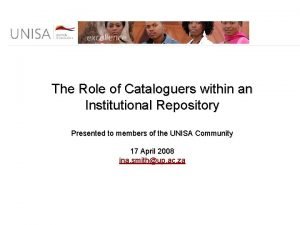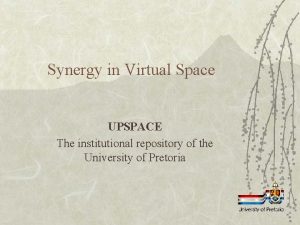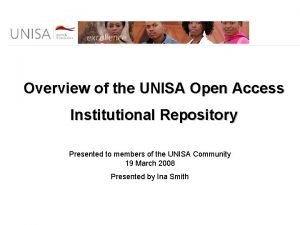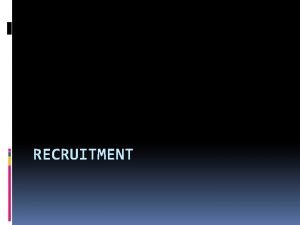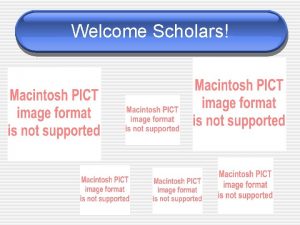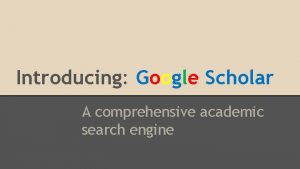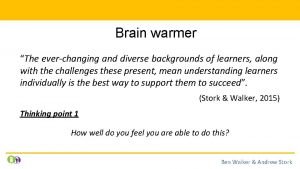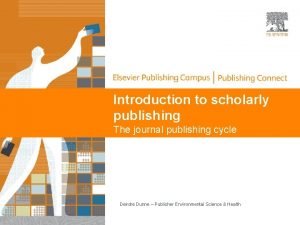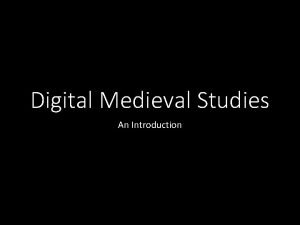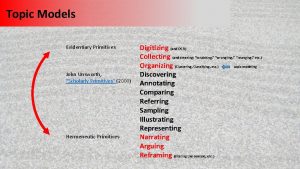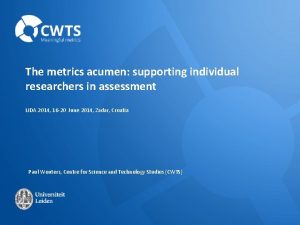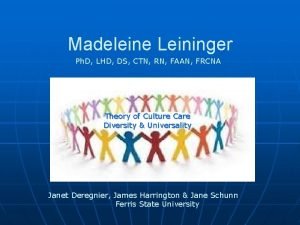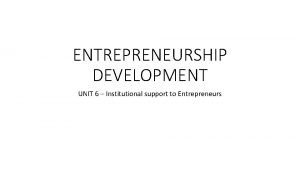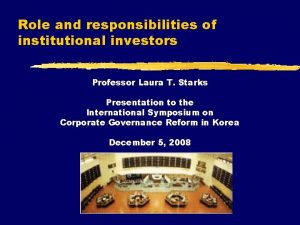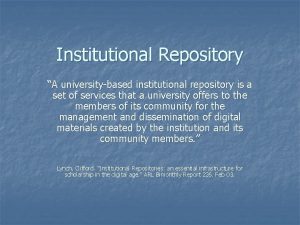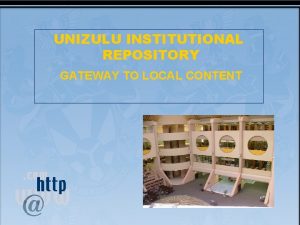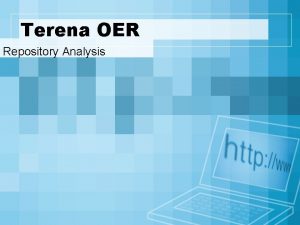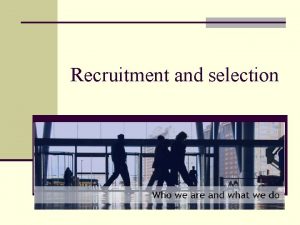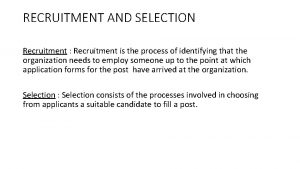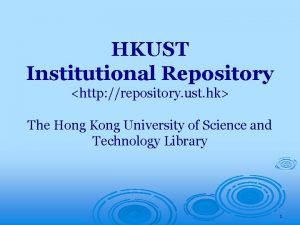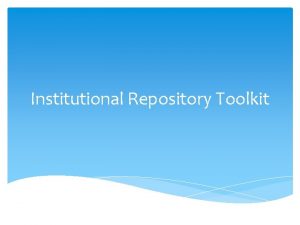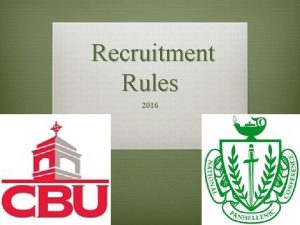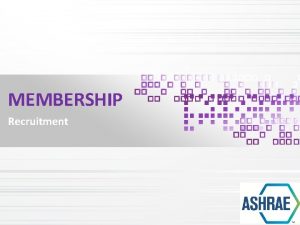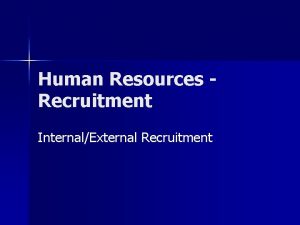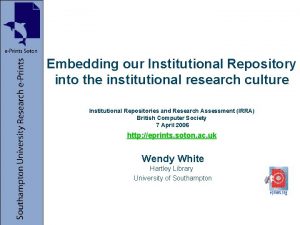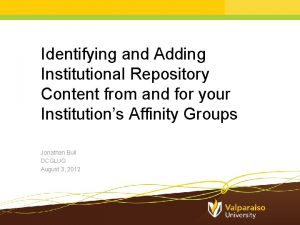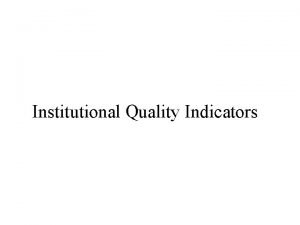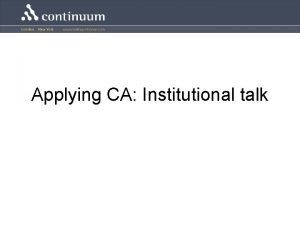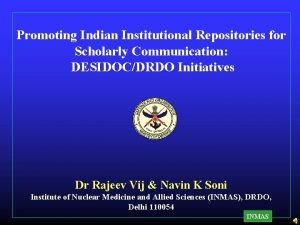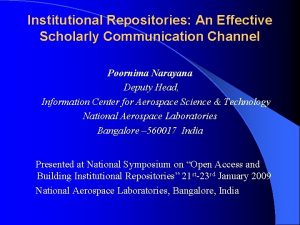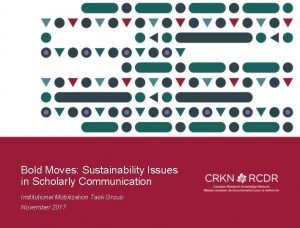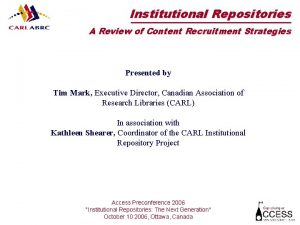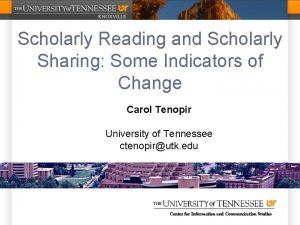Scholarly Communication and Content Recruitment for Institutional Repository

































































- Slides: 65

Scholarly Communication and Content Recruitment for Institutional Repository Presentation for GRADLIS 9315 Adrian K. Ho Scholarly Communication Librarian The University of Western Ontario Last updated on June 22, 2010 1

Scholarly Communication and Content Recruitment for Institutional Repository by Adrian K. Ho is licensed under a Creative Commons Attribution-Noncommercial 3. 0 License. The URLs of the online resources mentioned in this presentation are noted in alphabetical order at the end. Additional resources are also noted there. 2

What Is Scholarly Communication? • Scholarly communication (SC) is a cyclical process in which content is generated, reviewed, disseminated, acquired, preserved, discovered, accessed, and assimilated for the advancement of scholarship. • The assimilation can potentially lead to generation of new content and thus start a new iteration of the process (or lifecycle). 3

Scholarly Communication Lifecycle Source: Western Libraries, The University of Western Ontario 4

Scholarly Communication Lifecycle • Different stakeholders include but are not limited to: • • • Scholars/Researchers as authors Publishers Libraries Scholars/Researchers as readers Higher education institutions Research funding agencies 5

Scholarly Communication Lifecycle • Different topics include but are not limited to: • • Peer review Copyright Publication impact Collection development Acquisitions Information discovery Access 6

Issues of Current SC System • Lengthy process for content dissemination • Internet as a communication channel not fully utilized • Barriers to access due to business interests • Increasing financial burden for libraries • Changes in researchers’ information-seeking behaviour • Scholarship in the Digital Age: Information, Infrastructure, and the Internet 7

Concerns over Journal Publishing • Prices escalating, especially in Scientific, Technical, and Medical (STM) fields (“serials crisis”) • “Big deal” electronic journal packages: Impact on library budget and on selection of content • Licensing restrictions on access 8

Concerns over Journal Publishing • Less library funding for purchasing monographs • Limited sales of monographs • Fewer opportunities for monograph publishing, which has a negative impact on faculty promotion (especially in Arts and Humanities) • Business interests vs. Academic information needs 9

Reactions to Concerns • Academic libraries’ concerns over journal publishing have led to: • Promoting openness of scholarly content • Creating digital repositories to enhance access 10

Openness • Free flow and sharing of information and ideas for teaching, learning, and research (with adequate acknowledgement of sources) • Available to all for retrieval and/or contribution • Facilitated by Internet as the communication channel • Conducive to knowledge acquisition and generation • Open Knowledge Definition 11

Open Access (OA) A principle of disseminating scholarly content Online Free of charge Free of most copyright and licensing restrictions • Made possible by the Internet and consent of copyright holders • Higher visibility and accessibility of content • • 12

Open Access (OA) • Compatible with peer review • Faster information exchange • OA journals less expensive to produce than conventionally published journals • Questions about economic sustainability • Open Access: The New World of Research Communication (video) • What Is the Future of Open Access? (video) 13

Types of Open Access • Green OA: Making (peer-reviewed) manuscripts of published journal articles freely available online • Gold OA: Made possible by publishing in online books or journals that are freely available for access, e. g. , journals published by the Public Library of Science • The Directory of Open Access Journals lists online journals that embody gold OA. 14

Types of Open Access • Gratis OA: Content made freely available online but with copyright restrictions • Libre OA: Content made freely available online with certain copyright restrictions removed • Creative Commons licenses enable libre OA by specifying the permissions and restrictions • Wanna Work Together? (video) 15

Other Types of Openness • Open data: Research data collected with public funding to be made freely available for other researchers to access and build upon • NRC-CISTI’s Gateway to Scientific Data provides easier access to data collected by Canadian researchers • Open Data and the Future of Funded Research (video) • Panton Principles for open data 16

Other Types of Openness • Open education: Making educational resources more accessible • Also improving education quality by facilitating review of and feedback to educational practices and pedagogies • Collaborative extension of educational resources among educators, i. e. , building upon each other’s work • MIT Open. Course. Ware and Connexions 17

Other Types of Openness • Open Notebook Science: Sharing notes about the work and progress of a research project online, e. g. , RRResearch and Useful Chem Project • Open Science: Good for Research, Good for Researchers? (video) • Concise and to-the-point discussion of different types of openness in Battle of the Opens 18

Digital Repositories • Online archives that collect, organize, store, and preserve digital materials • Also databases that enable users to search and access the collected materials • Channels for green open access 19

Types of Digital Repository Source: Open. DOAR 20

Types of Digital Repository • Disciplinary repository: A subject-based online archive that expedites information exchange among members of an academic community, e. g. , ar. Xiv, Pub. Med Central Canada, Re. PEc, etc. • Institutional repository: An online archive created and maintained by an educational or research institution to collect, showcase, and preserve their intellectual output, e. g. , c. IRcle, Scholarship@Western, T-Space, etc. 21

Types of Digital Repository • Aggregating repository: An online archive that facilitates access to digital content from different individual repositories, e. g. , Theses Canada, ETh. OS, DART-Europe, etc. • Governmental repository: An online archive for digital content generated by government agencies, e. g. , NPAr. C, OSTI, Geoscience Data Repository, etc. 22

Types of Digital Repository • Three directories of open access digital repositories: • Open. DOAR (Directory of Open Access Repositories) • Repository 66 • ROAR (Registry of Open Access Repositories) 23

Types of Digital Repository • Not all digital repositories offer free access to their content because some were created for internal use within organizations. • The focus of this presentation is on open access institutional repositories, i. e. , those that are created and maintained by educational or research institutions and their content is freely available for public access. 24

Institutional Repositories in Canada Source: Canadian Association of Research Libraries 25

Why Institutional Repository? • Benefits for Institution • • Active contribution to scholarship and public good Enhancement of profile as research institution Accountability for public investment International recognition of academic achievements Beneficial to global researcher networking Beneficial to recruitment of faculty and students Useful tool for assessment of research output Potential tool for fund raising 26

Why Institutional Repository? • Benefits for Content • Higher visibility and accessibility • Potentially more discussion and feedback • Potentially more citations and impact • Benefits for Researchers • Potentially more recognition in academic community and outside of academia • Potentially more competitive for future research funding thanks to the recognition • Compliance with research funding agencies’ public access policies • Why Repositories? (video) 27

Basic Components of Repository • Hardware: A server and other required equipment • Software: The platform to present content. Common platforms include DSpace, e. Prints, Fedora, and Digital Commons • Content • Metadata of content 28

Common Content Types • • Journal articles Books and book chapters Conference papers and presentations Electronic theses and dissertations Technical reports Working/Discussion papers Research datasets Learning objects 29

Functions of Metadata • Describe content for the purpose of organizing it • Facilitate discovery of content by repository users • Facilitate indexing of content by external systems, e. g. , search engines • Support archiving and preservation, especially with regard to file format and systems requirement 30

Technical Aspects of Repository • Online resources about technical aspects of institutional repositories: • Digital Repositories Info. Kit • Metadata in Repositories • Utah Digital Repository Toolkit 31

Management of Repository • Planning: Mission, content types, resource allocation, policy development, etc. • Budgeting: Costs of hardware, software, staff, ongoing maintenance, etc. • Staffing: Staff size, required skill sets, classification and rank, etc. • Promotion/Marketing: Strategies, targets, desired outcomes, etc. 32

Management of Repository • Content recruitment: How to attract content, who to submit content, what format, etc. • Access to content: Indexing by search engines, online exposure, discovery by users, etc. • Content preservation: Reformatting, future usability, etc. • Assessment: Review of content development, download statistics, staffing requirement, etc. 33

Management of Repository • Online resources about management of institutional repositories: • Digital Repositories Info. Kit • Utah Digital Repository Toolkit 34

Content Recruitment • This presentation focuses on content recruitment. • It is important to create a collection/content policy to guide the development of the repository. • The policy should be reviewed periodically in view of the institutional environment and other relevant factors. 35

Collection/Content Policy • Commons Issues addressed by the policy: • What criteria are used to define the scope of the repository? • What types of content are collected? • What is the appropriate format? • Who is eligible to submit content? • How is content submitted? • What metadata should be collected from the contributor? 36

Collection/Content Policy • How is submitted content handled, organized, and made available for access? • How are different versions of the submitted material managed? • What copyright issues are involved? • How are publishers’ copyright restrictions handled? • Is it possible to withdraw submitted content? • What are the plan and procedures for backup and preservation? 37

Collection/Content Policy • Examples of repository collection/content policy: Atrium (University of Guelph) c. IRcle (University of British Columbia) DSpace (University of Calgary) QSpace (Queen’s University) Scholarship@Western (The University of Western Ontario) • T-Space (University of Toronto) • • • 38

Strategies for Content Recruitment • Identify potential contributors, assess their needs for scholarly communication, and determine how the repository can meet those needs, e. g. , the repository can help raise the profile of a newly founded research centre by posting its researchers' writings online 39

Strategies for Content Recruitment • Collaborate with subject librarians and library administrators to proactively reach out to academic departments and the institution’s administration, and promote the benefits of contributing content to the repository, e. g. , delivering presentations at departmental meetings, answering questions about scholarly communication issues from individual faculty members and students, etc. • On Faculty Outreach (video) 40

Strategies for Content Recruitment • Customize talking points for potential contributors in light of the fact that different disciplines have their own cultures, e. g. , providing more information and concrete examples of open access and online publishing using a repository when reaching out to disciplines that are less familiar with or receptive to these topics 41

Strategies for Content Recruitment • Provide education and/or information about copyright restrictions and open access to highlight the benefits of submitting content to the repository, e. g. , organizing workshops on ensuring open access to published research, distributing brochures about open access and digital repositories, etc. • Greater Reach for Your Research: Expanding Readership through Digital Repositories 42

Strategies for Content Recruitment • Encourage different campus constituencies to adopt the repository as the platform for the dissemination of locally generated scholarly content, e. g. , working papers, technical reports, student research journals, etc. 43

Strategies for Content Recruitment • Identify faculty allies on campus and invite them to participate in content recruitment activities, e. g. , inviting local open access advocates to speak on the positive impact of submitting content to the repository 44

Strategies for Content Recruitment • Collaborate with allies on campus to develop a mandate to require submission of faculty's scholarly articles to the repository, e. g. , MIT's faculty voted to implement an institution-wide open access mandate: MIT faculty open access to their scholarly articles • The Harvard Open Access Initiatives (video) 45

Strategies for Content Recruitment • Partner with relevant campus units to draw potential contributors’ attention to the benefits of submitting content to the repository, e. g. , working with the institution's research office to promote the repository as an avenue for the compliance with research funding agencies’ policies that funded researchers must make their findings available online for free public access 46

Strategies for Content Recruitment • Work with the media outlets on campus to raise the institution's awareness of the repository and its benefits, e. g. , providing relevant information to the campus newspapers and make yourself available for interviews • Use the library's communication/marketing channels to promote the repository and the benefits of contributing content 47

Strategies for Content Recruitment • This list is by no means exhaustive. There have been discussions about this topic: • • Institutional repositories (collection strategies) Advice on filling your repository Content recruitment for institutional repositories Collecting for digital repositories 48

Potential Contributors’ Questions • Potential contributors often bring up a variety of questions. A common one is about the copyright restrictions on their articles published in subscription-based journals. • SHERPA/Ro. MEO provides information about journal publishers’ permissions and restrictions on articles they publish. Authors can use it to find out whether they can make their published articles freely available online. • Using Sherpa/Ro. MEO Examples 49

Potential Contributors’ Questions • It is likely that the library has to provide assistance with clarifying journal publishers’ permissions and restrictions. • Authors should be alerted to the fact that they can use an addendum to retain certain rights over their yet-to-publish articles, e. g. , SPARC Canadian Author Addendum • Retaining Copyright in Journal Articles • Know Your Rights: Who Really Owns Your Scholarly Works? (video) 50

Potential Contributors’ Questions • Other questions include but are not limited to: • What benefits are there for me as a scholar? (Explain the benefits of open access and institutional repositories, especially those from the scholar’s perspective) • Aren’t scholarly articles already available in databases? (Point out that databases are commercial products and are available to the campus community because of the library’s subscriptions) 51

Potential Contributors’ Questions • Will submitted content remain available over time? (Talk about the backup and preservation measures for the repository) • How will people find the content submitted to the repository? (Explain that the content is indexed by search engines and harvesters such as OAIster and CARL Open Archives Metadata Harvester) 52

Potential Contributors’ Questions • Is there help with submitting content to the repository? (Provide timely assistance or submission service if possible) • How will I know if my articles have been accessed? (Point out that there are download statistics for contributors) • The repository’s collection/content policy may come in handy when answering some of these questions. 53

Barriers to Content Recruitment • What do you think impedes content recruitment for an institutional repository? 54

Online Resources Mentioned Advice on Filling Your Repository http: //ways. org/en/blogs/2010/mar/26/advice_on_filling_an_open_access_repository ar. Xiv http: //arxiv. org/ Atrium’s Collection/Content Policy http: //atrium. lib. uoguelph. ca/content. Policy. html Battle of the Opens http: //scienceblogs. com/bookoftrogool/2010/03/battle_of_the_opens. php Canadian Institutional Repositories http: //www. carl-abrc. ca/projects/institutional_repositories/canadian_projects-e. html CARL Open Archives Metadata Harvester http: //carl-abrc-oai. lib. sfu. ca/index. php/browse c. IRcle’s Collection/Content Policy http: //www. library. ubc. ca/circle/policies_b. html 55

Online Resources Mentioned Collecting for Digital Repositories http: //ir. lib. uwo. ca/wlpub/12/ Connexions http: //cnx. org/ Content Recruitment for Institutional Repositories http: //ir. lib. uwo. ca/wlpub/6/ Creative Commons Licenses http: //creativecommons. org/about/licenses/ DART-Europe http: //www. dart-europe. eu/basic-search. php Digital Commons http: //www. bepress. com/ir/ Digital Repositories Info. Kit http: //www. jiscinfonet. ac. uk/infokits/repositories/index_html 56

Online Resources Mentioned Directory of Open Access Journals http: //www. doaj. org/ DSpace http: //www. dspace. org/ DSpace at the University of Calgary’s Collection/Content Policy http: //library. ucalgary. ca/services/information-faculty/open-access/institutionalrepository-policies#Content e. Prints http: //www. eprints. org/ ETh. OS http: //ethos. bl. uk/ Fedora http: //www. fedora-commons. org/ Gateway to Scientific Data http: //data-donnees. cisti-icist. nrc-cnrc. gc. ca/gsi/ctrl? lang=en 57

Online Resources Mentioned Geoscience Data Repository http: //gdr. nrcan. gc. ca/index_e. php Greater Reach for Your Research: Expanding Readership through Digital Repositories http: //www. carl-abrc. ca/projects/author/sparc_repositories. pdf The Harvard Open Access Initiatives http: //scholcomm. columbia. edu/content/harvard-open-access-initiatives Institutional Repositories (Content Recruitment Strategies) http: //digitalcommons. unl. edu/library_talks/54/ Know Your Rights: Who Really Owns Your Scholarly Works? http: //scholcomm. columbia. edu/know-your-rights-who-really-owns-your-scholarlyworks Metadata in Repositories http: //www. wrn. aber. ac. uk/objects/metadata_overview/ MIT Faculty Open Access to Their Scholarly Articles http: //web. mit. edu/newsoffice/2009/open-access-0320. html 58

Online Resources Mentioned MIT Open. Course. Ware http: //ocw. mit. edu/Ocw. Web/web/home/index. htm NPAr. C http: //nparc. cisti-icist. nrc-cnrc. gc. ca/npsi/ctrl OAIster http: //oaister. worldcat. org/ On Faculty Outreach http: //vimeo. com/2902879 Open Access: The New World of Research Communication http: //www. carl-abrc. ca/projects/open_access/October_10_2007 -e. html Open Data and the Future of Funded Research http: //scholcomm. columbia. edu/open-data-and-future-funded-research Open Knowledge Definition http: //www. opendefinition. org/okd 59

Online Resources Mentioned Open Science: Good for Research, Good for Researchers? http: //scholcomm. columbia. edu/open-science-good-researchers Open. DOAR (Directory of Open Access Repositories) http: //www. opendoar. org/ OSTI http: //www. osti. gov/ Panton Principles http: //pantonprinciples. org/ Public Library of Science http: //www. plos. org/ Publication Impact http: //scholcomm. columbia. edu/final-impact-what-factors-really-matter Pub. Med Central Canada http: //pubmedcentralcanada. ca/ 60

Online Resources Mentioned QSpace’s Collection/Content Policy http: //library. queensu. ca/services/qspace/guidelines/policies Re. PEc http: //www. repec. org/ Repository 66 http: //maps. repository 66. org/ Retaining Copyright in Journal Articles (CAUT Intellectual Property Advisory) http: //www. carl-abrc. ca/projects/author/ip-advisory 1 -en. pdf ROAR (Registry of Open Access Repositories) http: //roar. eprints. org/ RRResearch http: //rrresearch. blogspot. com/ Scholarly Communication Lifecycle http: //www. lib. uwo. ca/scholarship/scholarlycommunication. html 61

Online Resources Mentioned Scholarship in the Digital Age: Information, Infrastructure, and the Internet http: //scholcomm. columbia. edu/scholarship-digital-age-information-infrastructureand-i Scholarship@Western http: //ir. lib. uwo. ca/ Scholarship@Western’s Policies http: //ir. lib. uwo. ca/about. html SHERPA/Ro. MEO http: //www. sherpa. ac. uk/romeo/ SPARC Canadian Author Addendum http: //www. carl-abrc. ca/projects/author-e. html#addendum T-Space https: //tspace. library. utoronto. ca/ T-Space’s Collection/Content Policy https: //tspace. library. utoronto. ca/policies/comm-and-coll. jsp 62

Online Resources Mentioned Theses Canada http: //www. collectionscanada. gc. ca/thesescanada/index-e. html Useful Chem Project http: //usefulchem. wikispaces. com/ Using Sherpa/Ro. MEO Examples http: //harvester. lib. utah. edu/utah_ir_toolkit/copyright/sherpa. html Utah Digital Repository Toolkit http: //harvester. lib. utah. edu/utah_ir_toolkit/ Wanna Work Together? http: //creativecommons. org/videos/wanna-work-together What Is the Future of Open Access? http: //blogs. law. harvard. edu/mediaberkman/2009/03/03/what-is-the-future-of-openaccess/ Why Repositories? http: //vimeo. com/2900682 63

Additional Resources Assessing the Future Landscape of Scholarly Communication http: //escholarship. org/uc/cshe_fsc Digital Repository Management Uncovered https: //www. ideals. illinois. edu/handle/2142/15083 A Field Guide to Misunderstandings about Open Access http: //www. earlham. edu/~peters/fos/newsletter/04 -02 -09. htm#fieldguide Institutional Repositories, Tout de Suite http: //www. digital-scholarship. org/ts/irtoutsuite. pdf Institutional Repository Bibliography http: //www. digital-scholarship. org/irb. html Open Access Overview http: //www. earlham. edu/~peters/fos/overview. htm The University’s Role in the Dissemination of Research and Scholarship http: //www. arl. org/bm~doc/disseminating-research-feb 09. pdf 64

Adrian K. Ho Scholarly Communication Librarian Western Libraries The University of Western Ontario (519) 661 -2111 x 87832 adrian. ho@uwo. ca 65
 Unisa institutional repository
Unisa institutional repository Upspace institutional repository
Upspace institutional repository Unisa research repository
Unisa research repository What is recruitment
What is recruitment Scholarly publishing and academic resources coalition
Scholarly publishing and academic resources coalition Habits of scholars
Habits of scholars Google scholar
Google scholar Scholarly tutoring
Scholarly tutoring Project management scholarly articles
Project management scholarly articles Scholarly articles
Scholarly articles Scholarly
Scholarly Scholarly primitives
Scholarly primitives Scholarly acumen
Scholarly acumen Madeleine leininger scholarly articles
Madeleine leininger scholarly articles Csun scholarly articles
Csun scholarly articles Characteristics of esp
Characteristics of esp Static content vs dynamic content
Static content vs dynamic content Need for institutional support
Need for institutional support Roles and importance of institutional investors
Roles and importance of institutional investors Fspos
Fspos Typiska novell drag
Typiska novell drag Nationell inriktning för artificiell intelligens
Nationell inriktning för artificiell intelligens Returpilarna
Returpilarna Shingelfrisyren
Shingelfrisyren En lathund för arbete med kontinuitetshantering
En lathund för arbete med kontinuitetshantering Personalliggare bygg undantag
Personalliggare bygg undantag Tidbok yrkesförare
Tidbok yrkesförare A gastrica
A gastrica Vad är densitet
Vad är densitet Datorkunskap för nybörjare
Datorkunskap för nybörjare Tack för att ni lyssnade bild
Tack för att ni lyssnade bild Hur skriver man en debattartikel
Hur skriver man en debattartikel Delegerande ledarskap
Delegerande ledarskap Nyckelkompetenser för livslångt lärande
Nyckelkompetenser för livslångt lärande Påbyggnader för flakfordon
Påbyggnader för flakfordon Vätsketryck formel
Vätsketryck formel Svenskt ramverk för digital samverkan
Svenskt ramverk för digital samverkan Lyckans minut erik lindorm analys
Lyckans minut erik lindorm analys Presentera för publik crossboss
Presentera för publik crossboss Argument för teckenspråk som minoritetsspråk
Argument för teckenspråk som minoritetsspråk Kanaans land
Kanaans land Treserva lathund
Treserva lathund Fimbrietratt
Fimbrietratt Claes martinsson
Claes martinsson Centrum för kunskap och säkerhet
Centrum för kunskap och säkerhet Lågenergihus nyproduktion
Lågenergihus nyproduktion Mat för unga idrottare
Mat för unga idrottare Verktyg för automatisering av utbetalningar
Verktyg för automatisering av utbetalningar Rutin för avvikelsehantering
Rutin för avvikelsehantering Smärtskolan kunskap för livet
Smärtskolan kunskap för livet Ministerstyre för och nackdelar
Ministerstyre för och nackdelar Tack för att ni har lyssnat
Tack för att ni har lyssnat Mall för referat
Mall för referat Redogör för vad psykologi är
Redogör för vad psykologi är Borstål, egenskaper
Borstål, egenskaper Atmosfr
Atmosfr Borra hål för knoppar
Borra hål för knoppar Orubbliga rättigheter
Orubbliga rättigheter Standardavvikelse
Standardavvikelse Tack för att ni har lyssnat
Tack för att ni har lyssnat Rita perspektiv
Rita perspektiv Verksamhetsanalys exempel
Verksamhetsanalys exempel Tobinskatten för och nackdelar
Tobinskatten för och nackdelar Blomman för dagen drog
Blomman för dagen drog Datumr
Datumr Egg för emanuel
Egg för emanuel
